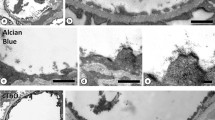Summary
This paper reports an unrecognized aspect of phosphotungstic acid staining at low pH. It provides an on-section staining method in which sialic acid-containing molecules can be demonstrated in the laminae rarae of the rat glomerular basement membrane. The staining in the basement membrane became negative after perfusion with the following cations: protamine sulphate, hexadimethrine, Alcian Blue, Ruthenium Red and Toluidine Blue. Blocking ws not achieved with Alcian Blue at about pH 1. The staining was also abolished after mild methylation and demethylation restored the contrast. This is suggestive of the involvement of carboxyl groups. Prior digestion with pronase, trypsin and neuraminidase rendered the laminae rarae negative, whereas hyaluronidase, chondroitinase ABC and crude heparinase were without effect. This indicates that sialic acid groups are detected by this method and that heparan sulphate does not interfere. The staining of the epithelial plasma membrane, also carrying sialic acid groups, remained positive after neuraminidase treatment. It is presumed that this method can be applied successfully for detecting changes in the sialic acid content of the laminae rarae in rat glomerular basement membranes under normal and pathological conditions.
Similar content being viewed by others
References
Caulfield, J. P. (1979) Alterations in the distribution of Alcian Blue staining fibrillar anionic sites in the glomerular basement membrane in aminonucleoside nephrosis.Lab. Invest. 40, 503–11.
Courtoy, P. J., Timpl, R. &Farquhar, M. G. (1982) Comparative distribution of laminin, type IV collagen and fibronectin in the rat glomerulus.J. Histochem. Cytochem. 30, 874–86.
Faraggiana, T. &Grishman, E. (1981) The podocyte cell coat in experimental nephrosis.J. Ultrastruct. Res. 74, 296–306.
Faraggiana, T., Grishman, E. &Churg, J. (1982) Cell coat of podocytes in patients with nephrotic syndrome.Histopathology,6, 299–307.
Geyer, G. (1977) Elektronenmikroskopische Histochemie. Teil 1. Nachweisund Kontrastierungsmethoden für Kohlenhydrate. Proteine und Aminosaüren, Nucleinsaüren, Lipiden und Mineralstoffe. InHandbuch der Histochemie (edited byGraumann, W. andNeumann, K.), pp. 12–17. Stuttgart, New York: Gustav, Fischer Verlag.
Hunsicher, L. G., Shearer, T. P. &Schaffer, S. J. (1981) Acute reversible proteinuria induced by infusion of the polycation hexadimethrine.Kidney Int. 20, 7–17.
Jones, D. B. (1969) Mucosubstances of the glomerulus.Lab. Invest. 21, 119–25.
Kanwar, Y. S. &Farquhar, M. G. (1979) Presence of heparan sulphate in the glomerular basement membrane.Proc. natn. Acad. Sci. USA 76, 1303–7.
Kanwar, Y. S. &Farquhar, M. G. (1980) Detachment of endothelium and epithelium from the glomerular basement membrane produced by kidneys perfusion with neuraminidase.Lab. Invest. 42, 375–84.
Kanwar, Y. S., Hascall, V. C. &Farquhar, M. G. (1981a) Partial characterization of newly synthesized proteoglycans isolated from the glomerular basement membrane.J. Cell. Biol.,90, 527–32.
Kanwar, Y. S. &Rosenzweig, L. J. (1982) Altered glomerular permeability as a result of focal detachment of the visceral epithelium.Kidney Int. 21, 565–74.
Kanwar, Y. S., Rosenzweig, L. J. &Kerjaschki, D. I. (1981b) Glycosaminoglycans of the glomerular basement membrane in normal and nephrotic states.Renal Physiol. 4, 121–30.
Leduc, E. H. &Bernhard, W. (1967) Recent modifications of the glycolmetacrylate embedding procedure.J. Ultrastruct. Res. 19, 196–9.
Lillie, R. D. &Fullmer, H. M. (1976)Histopathologic Technic and Practical Histochemistry (edited byLillie, R. D. andFullmer, H. M.), pp. 319 and 639. New York: McGraw-Hill Inc.
Linker, A. &Hovingh, P. (1972) Heparinase and heparitinase from flavobacteria.Meth. Enzym. 28, 902–11.
Mynderse, L. A., Hassell, J. R., Kleinman, H. K., Martin, G. R. &Martinez-Hernandez, A. (1983) Loss of heparan sulfate proteoglycan from glomerular basement membrane of nephrotic rats.Lab. Invest. 48, 292–302.
Nevins, T. E. &Michael, A. F. (1981) Isolation of anionic sialproteins from the rat glomerulus.Kidney Int. 19, 553–63.
Pease, D. C. (1970) Phosphotungstic acid as a specific electron stain for complex carbohydrates.J. Histochem. Cytochem. 18, 455–7.
Quatacker, J. (1981) Relationship between the distribution of anionic sites and the glomerular permeability barrier.Biol. Cell 41, 3a.
Quatacker, J. (1983) Detection of neuraminidase-sensitive molecules in the laminae, rarae of the rat glomerular basement membrane.Biol. Cell. 48, 21a.
Reale, E., Luciano, L. &Kühn, K.-W. (1983) Ultrastructural architecture of proteoglycans in the glomerular basement membrane. A cytochemical approach.J. Histochem. Cytochem. 31, 662–8.
Reeves, W. H., Kanwar, T. S. &Farquhar, M. G. (1980) Assembly of the glomerular filtration surface. Differentiation of anionic sites in glomerular capillaries of newborn rat kidney.J. Cell Biol. 85, 735–53.
Schurer, J. W., Hoedemaeker, Ph. J. &Molenaar, I. (1977) Polyethyleneimine as tracer particle for (immuno) electron microscopy.J. Histochem. Cytochem. 25, 384–7.
Seiler, M. W., Venkatachalam, M. A. &Cotran, R. S. (1975) Glomerular epithelium: structural alterations induced by polycations.Science 189, 390–3.
Seiler, M. W., Rennke, H. G., Venkatachalam, M. A. &Cotran, R. S. (1977) Pathogenesis of polycations-induced alterations (‘fusion’) of glomerular epithelium.Lab. Invest. 36, 48–61.
Sorvari, T. E. &Stoward, P. J. (1970) Some investigations of the mechanism of the so-called ‘methylation’ reactions used in mucosubstance histochemistry. I ‘Methylation’ with methyliodide, diazomethane and various organic solvents containing hydrogen chloride or thionyl chloride.Histochemie 24, 106–13.
Spicer, S. S. (1960) A correlative study of the histochemical properties of rodent acid mucopolysaccharides.J. Histochem. Cytochem. 8, 18–36.
Spicer, S. S. &Shulte, B. A. (1982) Ultrastructural methods for localizing complex carbohydrates.Hum. Path. 13, 343–54.
Thiery, J. P. &Ovtracht, L. (1979) Differential characterization of carboxyl and sulfate groups in thin sections for electron microscopy.Biol. Cellulaire 36, 281–8.
Timpl, R., Rohde, H., Risteli, L., Ott, U., Roley, P. G. &Martin, G. R. (1982) Laminin.Meth. Enzym. 82, 831–7.
Author information
Authors and Affiliations
Rights and permissions
About this article
Cite this article
Quatacker, J. Demonstration of sialic acid groups in the glomerular basement membrane of the rat with phosphotungstic acid at low pH. Histochem J 17, 201–212 (1985). https://doi.org/10.1007/BF01003219
Received:
Revised:
Issue Date:
DOI: https://doi.org/10.1007/BF01003219




